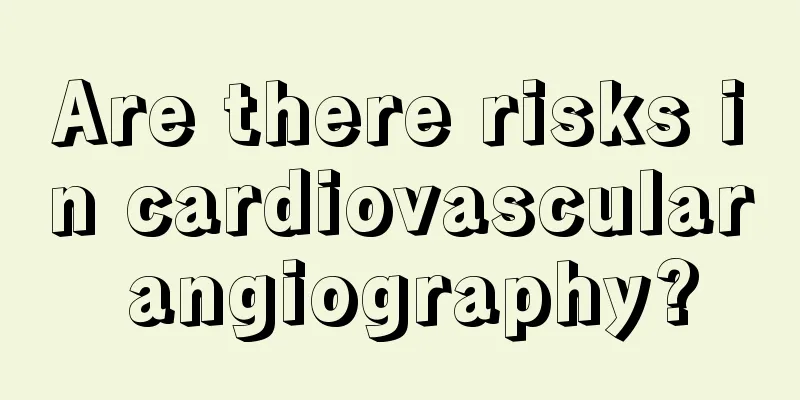Are there risks in cardiovascular angiography?

|
Cardiovascular angiography is a relatively mature technology at present. Common treatment methods include intravenous method, catheterization method, etc. As long as you choose a professional hospital, the risk will generally be small. However, if the blood environment is not improved during the operation, the chance of recurrence will be very high. Therefore, while undergoing cardiovascular angiography, you must also pay attention to your diet. In addition, proper exercise is also essential. 1. Is cardiac angiography dangerous? Cardiac angiography is a relatively mature technology and is generally not dangerous when performed in a hospital that performs this examination. However, there are still some problems due to the disadvantages of technology: 1. Cardiac angiography itself is not dangerous, but the process of inserting a catheter into the heart through the femoral artery is dangerous and may aggravate the occurrence of atrial fibrillation. The wound may bleed after the operation. 2. The use of cardiac angiography is mainly to find the exact location of vascular disease and seek ways to allow blood to pass through and unclog the blood vessels. However, since the blood environment has not improved, there is a certain chance of recurrence. 3. In angiography, when large doses of contrast agents are injected, there are many factors that affect their toxic effects. The risk of poisoning is several times greater with rapid injection than with slow injection. Under certain circumstances, tolerance of the myocardium, brain, spinal cord, or kidneys may be reduced. Physicians should choose appropriate contrast agents based on the patient's specific conditions. 4. Currently, the technology of cardiac angiography has matured, but a very small number of patients may have risks such as allergic reactions, thrombus detachment during surgery, postoperative bleeding, and infection. 2. Main methods of cardiovascular angiography ① Intravenous method: contrast agent is injected through subcutaneous puncture of the vein. This method performs imaging based on physiological circulation. Due to unsatisfactory imaging, there are still certain limitations on diagnosis. ② Catheterization method: mainly includes venous catheterization and arterial catheterization. Venous catheterization is a method of selectively placing a catheter into a specific cavity of the heart's large blood vessels through the vein, and injecting contrast agents to make them visible. This method has been widely used in the diagnosis of right heart, pulmonary artery and right-to-left shunt diseases; arterial catheterization refers to placing a catheter into the aorta or left atrium and ventricle through the artery, and injecting contrast agents to make them visible. This method has been widely used in the diagnosis of aorta, left ventricle and left-to-right shunt diseases. |
<<: Why are the blood vessels under the tongue purple and black?
>>: Prevention and treatment of vascular dark circles
Recommend
The hazards of hair conditioner
Women are very caring about their hair. Sometimes...
Birth control pills may reduce endometrial cancer risk
Can birth control pills reduce the risk of endome...
What to do if wisdom teeth are inflamed and have pus
When wisdom teeth become inflamed and abscesses a...
Are there any risks in rhinoplasty
The nose is the most important one among our five...
How many hours after a meal can you swim
Many people habitually go swimming after meals. S...
What causes nasopharyngeal cancer?
What causes nasopharyngeal cancer? 1. Nasopharyng...
Common symptoms of esophageal cancer need to be taken seriously
Esophageal cancer is a disease we often encounter...
Use 8 light exercises to relieve physical discomfort
In our daily lives, we often encounter indigestio...
Can I get pregnant if I have an ovarian tumor?
Ovarian tumors are very harmful to women. For man...
What is the reason for blue veins on fingers
Blue veins on fingers are a health problem that m...
Can I get pregnant with multiple fibroids of the breast? Can I get pregnant?
Women with multiple breast fibroids can get pregn...
What are the taboos of boiling water with ginger, jujube and brown sugar?
Using ginger, jujube and brown sugar to boil brow...
Tips for new leather shoes rubbing your feet on the heels
Many people like to wear new shoes, because new s...
What foods are the most detoxifying?
Everyone knows that some foods can help detoxify,...
How to massage to remove dark circles, teach you 6 acupoint massage
There are many reasons for dark circles. The most...









